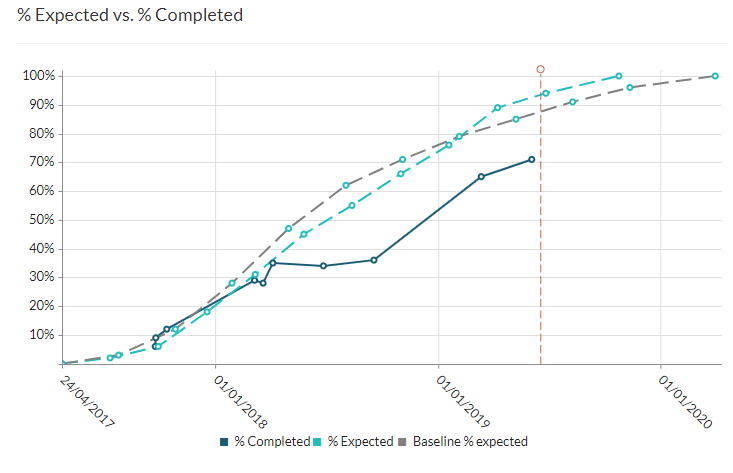Expected Progress of Summary Tasks and Projects
This article explains how the system calculates the expected progress of summary tasks and projects using two different models: Duration-Based Weighting and Effort-Based Weighting.
Duration-Based Weighting
The expected progress calculation based on duration assumes that work is completed uniformly over the course of the task’s duration. In this model, the progress at any point in time is determined solely by the proportion of the task’s duration that has elapsed.
For example, if a task is scheduled for 10 days and today is the 7th day, the expected progress is calculated as 70% (7 days elapsed out of 10 days total). This calculation also considers the default calendar settings and weekends in the task duration.
Once the expected progress for individual tasks is calculated, the system aggregates these values to determine the overall expected progress for summary tasks and projects.
Note: This calculation is a temporary projection. It may differ from actual reported progress because real productivity might not always align evenly with the passage of time.
Effort-Based Weighting
The Effort-Based Weighting model calculates expected progress by considering the distribution of work effort rather than just elapsed time. In many projects, work does not occur uniformly over the task’s duration; some periods may require more effort than others. This model takes that variability into account.
With Effort-Based Weighting, progress is weighted based on the planned or actual effort assigned to different parts of a task. For instance, if a task requires a burst of activity in the early phase and lighter work later on, the expected progress will be adjusted to reflect the higher effort initially. This approach provides a more realistic view of progress when the work intensity is not uniform throughout the task.
For a detailed explanation of how the Effort-Based Weighting model is implemented, please refer to the Calculated Progress – Effort-Based Weighting documentation.
Expected Progress of the Baseline
If you have an active baseline, the system calculates expected progress for both the ongoing planning and the baseline. This allows you to compare the two using the project tracking curve.

How Reliable Is the Expected Progress?
Both models provide a projection of progress:
- Duration-Based Weighting assumes work is evenly distributed over time.
- Effort-Based Weighting accounts for variations in work intensity.
These projections are temporary and do not necessarily represent the actual progress of a project unless work truly aligns with the assumed distribution. The system displays the actual reported progress, which may differ from the expected percentages calculated by either model.
Example:
Consider a task scheduled for 10 days. If more work is done during the initial days (as might be the case with Effort-Based Weighting), the reported progress could be higher than the progress expected solely by the elapsed time (Duration-Based Weighting). Conversely, if less effort is applied early on, the expected progress may be lower than the actual progress later in the task.
This dual-model approach helps project managers better understand where discrepancies might occur between planned progress and actual productivity.